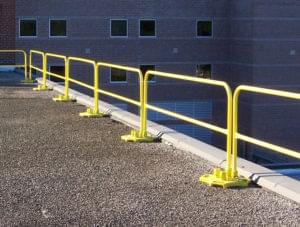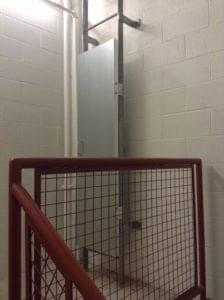Safety needs to be the number one priority of every supervisor and employee involved in a rooftop project. While it's not always possible to eliminate every potential hazard, it is crucial that they are identified and that the proper roof fall protection tools are put in place. So what’s the right tool for the job? We break down the six most critical areas you need to keep an eye on, and how to address each hazard.
 1. Leading Edges and Parapets: Guardrails
1. Leading Edges and Parapets: GuardrailsLeading edges and parapets pose obvious threats. The best way to protect employees is by eliminating these fall hazards altogether with guardrails. These fall protection systems keep employees from losing track of the edge as well as stop them from falling when they get too close.
OSHA rule 29 CFR §1926.501(b)(2)(i) states:
Each employee who is constructing a leading edge 6 feet (1.8 m) or more above lower levels shall be protected from falling by guardrail systems, safety net systems, or personal fall arrest systems. Guardrails must consist of a top rail, midrail or equivalent protection, and posts, and the vertical height must be within the range of 42" to 45" from the upper surface.
Skylights can be just as dangerous as leading edges. While sturdy enough for the elements, the glass used on skylights isn’t equipped to handle heavy weights — like that of an employee. Furthermore, they can crack or break from a dropped tool or other rooftop equipment. Guardrails or exterior skylight screens can prevent employees from accidentally stepping on or walking across the surface, eliminating the hazard altogether.
Hatches must be guarded with roof fall protection just like any other roof opening. Specially-designed hatch rail systems or guardrails installed to surround the hatch perimeter are a must. Furthermore, a safety gate will likely be needed to allow employees to come and go while keeping all four sides protected when the hatch is not in use. Workers with access to the hatch must be trained on both hatch cover and safety-gate best practices to ensure there are no accidental injuries — to themselves or others.
Regarding rooftop openings, OSHA states:
Every roof opening must be guarded by a cover, a guardrail, or equivalent on all open sides. If the cover is not in place, for any reason, the opening must be continually attended by a person, or protected by guardrails. Toeboards must also be installed around the edges at openings where someone may pass below the opening.
 4. Access Ladders: Guardrails, Gates, and/or Ladder Defenders
4. Access Ladders: Guardrails, Gates, and/or Ladder DefendersLadders should be protected with guardrails and a safety gate or full roof fall protection ladder system. A guardrail placed at the top of the ladder creates a clear demarcation and protects workers from a potential fall. And when placed at the bottom of a ladder, a ladder guard protect against unauthorized access.
While we’re talking about ladders, personal fall protection devices might also be necessary for the workers that utilize them, and permanent ladders must be securely affixed to the wall. All ladders must meet OSHA's ladder standards: ladder rungs, steps, and cleats must be level, parallel, spaced uniformly when the ladder is in position. They also can’t be spaced less than 10", or more than 14", when measured between the center line.
When it comes to inclement weather, roof fall protection is a must. Wind, rain, snow, and ice can create slippery situations for even the most sure-footed employee. Hopefully, your workers won’t have to go up on the roof in these conditions, but you never know when damage from the weather will strike. By installing fall protection systems like guardrails on your rooftop, you’ll be ready to make repairs at a moment’s notice no matter what time of year it is.
One of the easiest and most effective ways to eliminate the potential for a rooftop fall is to limit access to only those workers who have been thoroughly trained. Keeping roof hatches locked, removing temporary ladders, providing OSHA-compliant fall protection systems, and monitoring other access points just makes good sense. But before any worker can perform a task on the rooftop, make sure they undergo thorough rooftop safety training. It doesn't matter if they have years of experience or if they're new to the job.
Industrial rooftop work is a dangerous undertaking. Roof fall protection must be top of mind for everyone. Part of that means using the right tool for the job. By following the guidelines above, you’ll be on the right track to making sure your workers are safe and efficient.